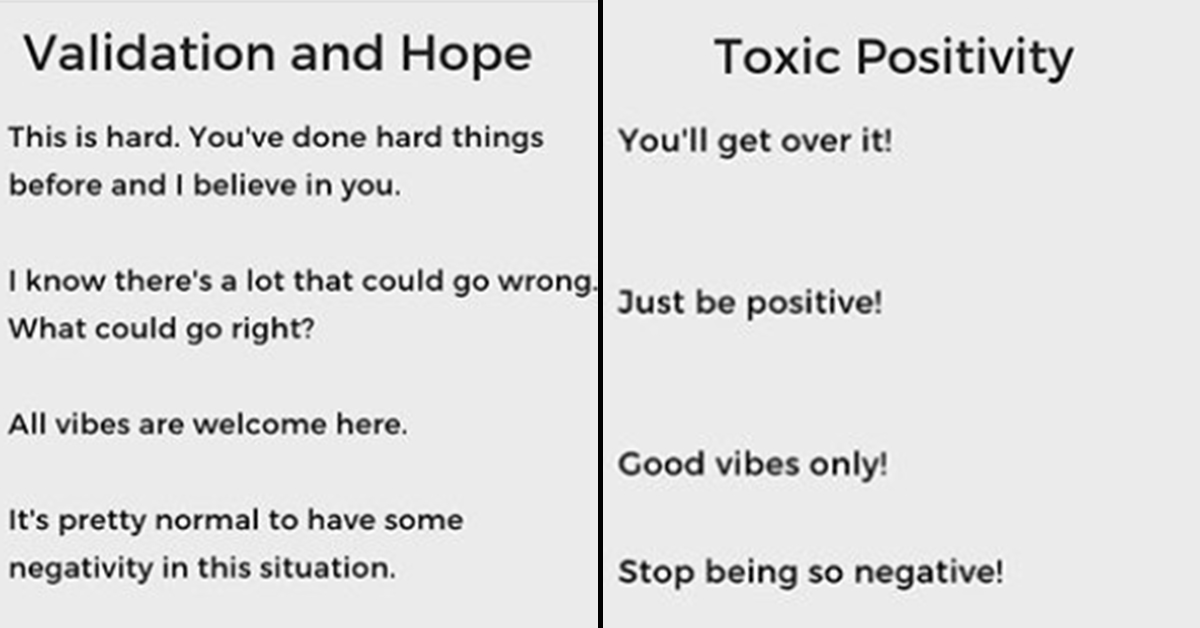Therapist Shares Chart Explaining The Difference Between “Toxic Positivity” And True Support
Keeping a positive attitude can certainly be a good thing. Negativity wears you down and can keep you from living life to its full potential, whereas positivity can help reduce stress and help you enjoy even the small moments in your day-to-day life.
But encouraging others to stay positive gets a little trickier. It’s a safe bet that everyone has experienced moments where you were feeling down in the dumps and a well-intentioned friend or family member said something along the lines of “just cheer up!” And shockingly enough, being told to take on a specific attitude probably didn’t magically make it happen.
Whitney Goodman, a psychotherapist who utilizes Instagram to spark conversations about mental health, shared a post highlighting what she refers to as “toxic positivity.”
“Alone, [these positive sayings are] pretty benign,” she writes. “But for someone who is really struggling they can sting. I translated them into some different variations that I think still inspire hope, but are validating.”
The differences between the “toxic positivity” and Goodman’s suggestions are pretty clear.
The original responses are simple and center around being positive for nothing more than positivity’s sake. They offer no helpful suggestions for moving forward and away from a negative outlook, and also invalidate any negative feelings with the implicit suggestion that it’s just so easy to be positive instead.
“The core of toxic positivity is that it’s dismissive and it shuts down the conversation. It effectively says “nope, that feeling you’re experiencing, it’s wrong and here’s why you should be happy instead.” It’s the exact opposite of what we want to do when people are in pain” pic.twitter.com/T9pJ6kN2Mt
— Omar Raza (@OmarRaza) June 17, 2020
And changing toxic positivity to validation, hope, and action is especially important in the current times we’re living through.
In addition to the “racism edition” of the toxic positivity chart shared above, Goodman has also made a version for addressing anxiety people may express during the current pandemic.
The key in every instance is to listen to the person expressing negative emotions or concerns and be supportive.
Sometimes you can help change whatever’s causing their concerns, and sometimes it’s completely out of your hands. But either way, as Goodman says: “Positivity becomes ‘toxic’ or ‘dismissive’ when we don’t leave space for validation or understanding. This usually happens when we rush into positivity.”
“The best way to help someone feel positive is to give them the space to feel & then meet them there,” she adds.
I feel very strongly about toxic positivity. Sometimes shit just sucks and you don’t always have to find the positive thing about it. Stop looking for the silver lining when things are bad. It’s fine to feel sad angry or afraid, c’est la vie. pic.twitter.com/yvlPOKlGwQ
— UltraMarine (@Obviouslywaffle) June 18, 2020
The idea of “toxic positivity” is catching on, as people strive to find a balance between optimism and anger at the injustices happening all around us.
It is healthy to be angry.
I’m not gonna go up to a Nazi or
some white supremacist & be like —“Good vibes?”
Fuck that.
I can be happy.
But don’t guilt me for being pissed off too.— ’ . (@CriticalBard) June 13, 2020
Honestly, you CANNOT & SHOULD NOT be positive all the time. You should be seeking to view things as they are, & sometimes, shit is SIMPLY fucked up.
Look how useless all the “good vibes only” people are being right now, ignoring all the harm coming to the world.
That’s toxic.
— wired. (@KhalypsoThePoet) June 14, 2020
U know what im getting tired of toxic positivity
— crybaby (@6foot1badbitch) June 11, 2020
Toxic positivity is denying and avoiding negative emotions, conflicts and problems. Yes its ok to think positively but dont stop there. Confront brutal facts, acknowldge the red flags and learn to resolve conflicts.
— Boiling Waters (@boilingwatersph) June 17, 2020
Toxic positivity will have you feeling annoyed by your timeline exposing the violence and ignorance of white supremacy instead of feeling enraged and disappointed by it.
— Nicola Foti (@soundlyawake) June 18, 2020

